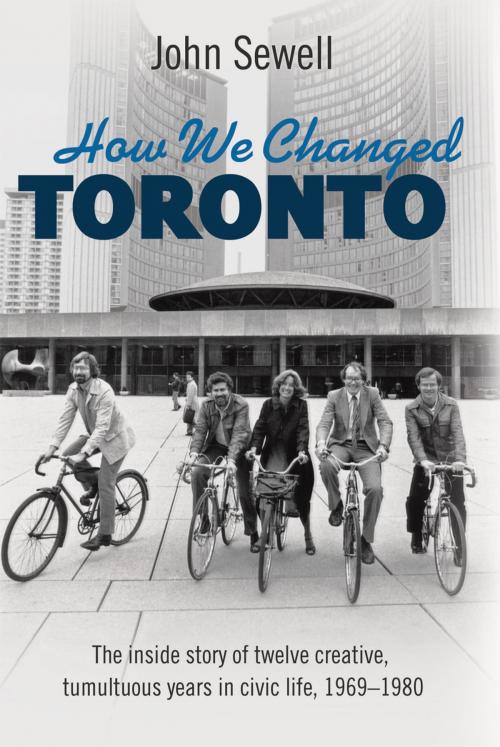How We Changed Toronto
The inside story of twelve creative, tumultuous years in civic life, 1969-1980
Nonfiction, Social & Cultural Studies, Political Science, Politics, City Planning & Urban Development, Government, Civics, International| Author: | John Sewell | ISBN: | 9781459409415 |
| Publisher: | James Lorimer & Company Ltd., Publishers | Publication: | September 21, 2015 |
| Imprint: | Lorimer | Language: | English |
| Author: | John Sewell |
| ISBN: | 9781459409415 |
| Publisher: | James Lorimer & Company Ltd., Publishers |
| Publication: | September 21, 2015 |
| Imprint: | Lorimer |
| Language: | English |
By the mid-1960s Toronto was well on its way to becoming Canada's largest and most powerful city. One real estate firm aptly labelled it Boomtown. Expressways, subways, shopping centres, high-rise apartments, and skyscraping downtown office towers were transforming the city. City officials were cheerleaders for unrestricted growth.
All this "progress" had a price. Heritage buildings were disappearing. Whole neighbourhoods were being destroyed -- by city hall itself -- in the name of urban renewal and high-rise developers.
Many idealistic, young Torontonians didn't like what they saw. At a time when political activism was in the air, they engaged in local politics. Recently graduated lawyer John Sewell was one of many. He joined his friends working for local residents in areas targeted for demolition by city hall. Others were fighting the Spadina expressway, planned to push its way through the city to the lakeshore. Still others were saving Toronto's Old City Hall from demolition.
This was the modest start of a twelve-year transformation of Toronto, chronicled in John Sewell's new book. Bringing together a fascinating cast of characters -- from cigar-chomping developers to Jane Jacobs and David Crombie, from a host of ordinary citizens to some of the world's most innovative architects and planners -- Sewell describes the conflict-filled period when Toronto developed a whole new approach to city government, civic engagement, and planning policies.
Sewell went from activist organizer, to high-profile opposition politician, to leading light of a bare reform majority at city hall, to become Toronto's mayor. Along the way he sparked the rethinking of an amazing array of old ideas -- not just about how cities should grow, but about race relations, attitudes toward the LGBT community, and the role of police. His defeat in the city's 1980 election marked the end of a decade of dramatic transformation, but the changes this reform era produced are now entrenched -- in Toronto, but in other Canadian cities, too.
How We Changed Toronto is the inside story of activist idealists who set out to change the world -- and did, right in their own backyard.
By the mid-1960s Toronto was well on its way to becoming Canada's largest and most powerful city. One real estate firm aptly labelled it Boomtown. Expressways, subways, shopping centres, high-rise apartments, and skyscraping downtown office towers were transforming the city. City officials were cheerleaders for unrestricted growth.
All this "progress" had a price. Heritage buildings were disappearing. Whole neighbourhoods were being destroyed -- by city hall itself -- in the name of urban renewal and high-rise developers.
Many idealistic, young Torontonians didn't like what they saw. At a time when political activism was in the air, they engaged in local politics. Recently graduated lawyer John Sewell was one of many. He joined his friends working for local residents in areas targeted for demolition by city hall. Others were fighting the Spadina expressway, planned to push its way through the city to the lakeshore. Still others were saving Toronto's Old City Hall from demolition.
This was the modest start of a twelve-year transformation of Toronto, chronicled in John Sewell's new book. Bringing together a fascinating cast of characters -- from cigar-chomping developers to Jane Jacobs and David Crombie, from a host of ordinary citizens to some of the world's most innovative architects and planners -- Sewell describes the conflict-filled period when Toronto developed a whole new approach to city government, civic engagement, and planning policies.
Sewell went from activist organizer, to high-profile opposition politician, to leading light of a bare reform majority at city hall, to become Toronto's mayor. Along the way he sparked the rethinking of an amazing array of old ideas -- not just about how cities should grow, but about race relations, attitudes toward the LGBT community, and the role of police. His defeat in the city's 1980 election marked the end of a decade of dramatic transformation, but the changes this reform era produced are now entrenched -- in Toronto, but in other Canadian cities, too.
How We Changed Toronto is the inside story of activist idealists who set out to change the world -- and did, right in their own backyard.















